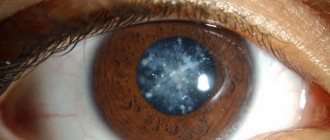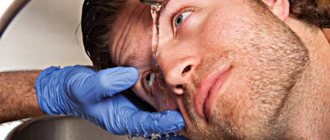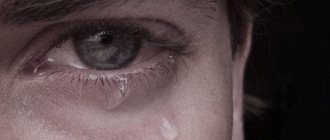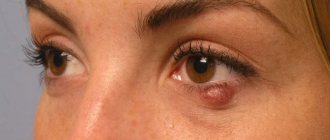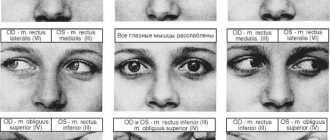Dry eye syndrome, otherwise called xerophthalmia, according to the logic of the name of the pathology, is an eye condition in which the surface of the cornea and conjunctiva are insufficiently moistened, which leads to its drying out. Burning and stinging, as well as other unpleasant sensations, appear.
Dry eye is diagnosed by a number of methods, including: biomicroscopy, Schirmer test, Norn test, conjunctival smear. That is, methods have been developed with which it is possible to reliably diagnose dry eye.
According to statistics, dry eye syndrome occurs quite often (from 9 to 18 percent of the total population). Of these, almost 70% are women. With age, the number of cases increases. For this reason, various tear substitutes, such as artificial tear drops, are being developed to treat the syndrome.
Composition of the tear film of the eye
- Mucous layer
. This part directly touches the human eye. The mucous component is produced by glands in the thickness of the eyelids and conjunctiva. - Water layer
. The composition includes water, various salts, proteins, and provides nutrition. It is formed by a gland located behind the upper eyelid. - Fat layer
. Located on top, it prevents excessively accelerated evaporation of moisture. It is produced in the same place as the first component.
A deviation in any of the three components of the system disrupts its entire operation.
Tear film of the eyes
The tear film of the eyes is a multicomponent substance located on the surface of the eyeball and performs an important function in receiving visual stimuli, and also protects the cornea from atmospheric oxygen, protects it from damage due to drying and has antibacterial properties.
Inflammation of the eye...
When you blink, the individual components of tears, created by the lacrimal glands, are distributed on the cornea of the eye, while the aqueous component of tears helps cleanse the eyes of impurities that have entered there.
We talk about the tear film rather than the tear layer because it has a complex structure and consists of three different, immiscible layers of liquid. It contains a layer of fat, water and mucus.
The layer of mucous membrane that lies directly on the corneal epithelium significantly reduces the surface tension of the tear film and allows the aqueous layer to evenly and quickly cover the surface of the epithelium. Disruption of this layer causes damage to the corneal epithelium, even when the amount of tears produced is sufficient.
The aqueous layer is responsible for creating the proper environment for epithelial cells, providing them with essential nutrients, and also cleanses the surface of the eye from metabolic products and foreign matter.
The outermost tear-fat layer protects the aqueous layer from evaporation and also ensures the stability and optical smoothness of the surface of the tear film.
The thickness of the tear film changes between blinks, but physiologically its structure remains constant.
Causes of dry eye syndrome
- Aging of the body
. An absolutely natural phenomenon that cannot be avoided. In young people, xerophthalmia is much less common than in old people. With age, the production of fatty secretions decreases by more than 50%, including in the area of the visual organs. The statistics especially concern the female gender; two thirds of those who fell ill and came for help were women. Due to the lack of fat, the secretion evaporates much faster, because the lipid layer is protective. - The root cause of an unpleasant deviation can be factors that are in no way dependent on the patient, for example, climate
: heat, gusty wind, sand worsen the situation. The same applies to regular stays in stuffy rooms with air conditioning and central heating. - smoking
. Smoke is extremely aggressive for the body and can cause both minor and very serious problems. Not to mention that smoking greatly harms the cardiovascular system, which affects the risk to the visual organs. - Reading
, constantly sitting in front of a monitor, and being addicted to various gadgets can provoke xerophthalmos. - Wearing poor quality contact lenses
can not only harm your health, but also cause myopia. Constant wearing and insufficient cleaning of any lenses can lead to xerophthalmos with complications. Hygiene is the first assistant of healthy people. - General health problems
: Parkinson's disease and Sjogren's syndrome, vitamin deficiency, hormone imbalance, menopause, taking certain pills. Vasodilators, contraceptives, antihistamines, and antidepressants make it difficult to produce tears. - cosmetics
(mascara, concealer, eyeliner, eye shadow) are extremely harmful. - Keratitis often appears in people who have had blepharoplasty
.
Functions
The main purpose of the mucous membrane is to protect the visual apparatus from external factors. The element also provides comfort when moving the eyeballs, due to secretions from numerous glands.
The production of the tear film is aimed not only at protecting the organ of vision, but also helps to moisturize it. For this reason, with pathologies affecting the inner lining of the eye, discomfort and a feeling of the presence of a foreign body appear.
The squamous epithelium, consisting of several layers, prevents microscopic dust particles from entering the eye. Even if small specks get there, they will be washed away by the tear fluid. Doctors distinguish two main functions of the conjunctiva - protective and secretory.
| Human tears contain immunoglobulins. These are substances that promote the death of pathogenic microorganisms. They protect the visual apparatus from the development of infection and inflammation. |
Return to contents
Symptoms of the disease
Symptoms of dry eye syndrome can manifest themselves in different ways, depending on its severity. Conventionally, all signs of the disease can be divided into two groups: subjective and objective.
| Subjective | Objective |
| Various types of unpleasant sensations: burning, pain, stinging | Xerotic changes in the outer membrane and conjunctiva |
| Sensation of sand or foreign object, need to rub eyelids | Hyperlacrimia - increased tear production occurs if corneal-conjunctival xerosis is not severe |
| Photophobia | With severe xerosis, lacrimation decreases and an acute feeling of dryness occurs. |
| Increased fatigue | |
| When instilling medications, a person feels discomfort | |
| Deterioration of vision |
Symptoms are aggravated if the environment and weather are unfavorable, and their manifestations intensify in the late afternoon. The condition of the visual organs is also worsened by prolonged work at the computer or in low light.
Clinical forms of corneal-conjunctival xerosis
Filamentous keratitis
. The conjunctiva does not become inflamed; numerous epithelial growths appear on the surface of the cornea.
Keratoconjunctivitis sicca
. The formations are inflammatory and degenerative in nature. The adhesion of the eyeballs to the conjunctiva is clearly expressed. Cloudiness, depressions, swelling, and loss of shine are noticeable on the whites. It becomes dull and rough.
Recurrent erosion
. It differs in that epithelial defects appear and disappear. They are superficial in nature and do not cause severe discomfort.
Failure to close the palpebral fissures (complete/partial) can aggravate the course of the disease. With a deficiency of vitamins, keratinization begins, as well as squamous mataplasia of the epithelium. One of the most serious consequences that xerophthalmos can lead to is corneal perforation.
Symptoms of damage to the conjunctiva of the eye
The clinical picture of damage to the mucous membrane largely depends on the type of pathology. Most often, patients encounter the following manifestations:
- Painful sensations that increase when blinking.
- Unbearable itching and burning.
- Increased secretion of tear fluid.
- Formation of neoplasms on the surface of the shell.
- Hyperemia of the conjunctiva as a result of vasodilation.
- Drying of the mucous membrane due to dystrophy.
- Discharge of pus.
- Sensation of the presence of a foreign object in the visual apparatus.
The occurrence of such symptoms is a serious incentive to visit a doctor.
Diagnosis of the disease
The patient may suspect that the disease he is suffering from is dry eye syndrome, but only an ophthalmologist can diagnose this pathology. A simple cursory inspection will not do the trick.
Firstly, biomicroscopy is prescribed for diagnosis to identify certain abnormalities in the appearance of the conjunctiva and outer membrane. Biomicroscopy is a slit lamp study. This stage reveals trichiasis, keratinization, symblepharon.
Secondly, it is worth assessing tear production. This is done like this: a diagnostic strip made of special paper is placed on the eyelids, then the speed of wetting of this strip is assessed. The test described is called the Schirmer test. As mentioned above, with a mild form of xerophthalmos, the rate of wetting is high, since tear production is increased. There are four wetting rates: variable, less than 1 mm in 5 minutes, less than 5 mm in 5 minutes, less than 2 mm in 5 minutes. This must be taken into account when making diagnostic conclusions.
Thirdly, in order to evaluate the film, the Norn test is performed. How quickly breaks and deformations appear determines its stability and how capable it is of wetting the cornea. It goes like this: the dye is instilled, then the time is recorded, and observation is carried out under a microscope. There are four break times: variable, more than 10 seconds inclusive, more than five seconds, immediate break. The tear film is also examined with a tiascope; the assessment is carried out based on parameters such as the thickness of the film layers and its structure.
Fourth, to diagnose dry eye syndrome, a fluid osmolarity test is necessary. If its level is elevated, this means that there is a moisture deficiency; liquid is not retained.
Also, to diagnose dry eye syndrome, studies such as fluorescein instillation test, crystallography, and cytological examination of smears are used.
All these manipulations and history taking are extremely important for accurate diagnosis and proper selection of further treatment.
Symptoms of xerophthalmia
Quite often people do not pay attention to the manifestation of the syndrome. They are of a hidden periodic nature. They become aggravated if xerophthalmia is accompanied by another disease or if it leads to the development of complications.
Most often, symptoms appear in both eyes. After sleep, the patient's eyelids stick together, he feels pain and dry eyes, and his eyes turn red. If dry eye syndrome is accompanied by complications, the following signs are added to the named symptoms:
- Decreased visual acuity.
- Unbearable pain in the eyes.
- Severe redness of the eyes for a long time.
- Fear of bright light.
Using an example, the symptoms of the syndrome look like this:
If you notice such manifestations, you should immediately visit a doctor.
Stages of the disease
Depending on the symptoms, the following stages of disease development are distinguished:
- Itching. Most often, this symptom is of an allergic nature. It appears because the dry cornea becomes sensitive and prone to irritation.
- Burning. When the cornea is insufficiently moisturized, the nerve endings send impulses to the brain that are recognized as a burning sensation.
- Foreign body sensation. The eyeball, suffering from a lack of moisture, becomes so dry that it seems to a person as if a speck has got into the eye. As a protective reaction, excessive secretion of the lacrimal glands is observed, which does not affect the degree of moisture of the conjunctiva and cornea.
- Redness. Insufficient hydration leads to the fact that the eyes do not receive enough nutrients. This provokes the development of the inflammatory process.
- Blurred image perception. By creating an even optical layer on the surface of the eye, tears allow it to perceive a clear picture. As this layer dries, it becomes uneven and the picture appears blurry.
- Tearing. Appears at the level of a reflex in response to a feeling of discomfort.
- Increased discomfort after visual stress. When concentrating on something, a person rarely blinks. As a result, dry eye syndrome manifests itself to a greater extent.
If you do not pay attention to the appearance of the syndrome in time, you can partially or completely lose the ability to see.
Treatment of dry eye syndrome
Self-diagnosis and self-medication are strongly not recommended; measures should be taken only after visiting an ophthalmologist.
Most often, medications similar in composition to natural tears are used to treat dry eye syndrome. With regular use of drops, many patients forget about pain and other discomfort. The drugs differ in viscosity and thickness; thicker ones continue to act longer.
When choosing drops, be sure to pay attention to whether they contain preservatives: their presence is undesirable, as they can cause additional irritation of the conjunctiva. Some remedies instantly relieve redness and inflammation, but doctors do not recommend them either, since the action occurs due to vasoconstriction, and the membrane is not moisturized. That is why they are not suitable for combating dry eye syndrome, but will only worsen the situation.
The choice of a drug to eliminate symptoms is carried out by trial and error: drugs are instilled and see if there is an improvement in the patient’s condition.
It happens that artificial tears do not bring any results, then another remedy is used - gels. Vidisik ophthalmic gel is widespread in Russia; it acts almost immediately, negating redness, inflammation, dryness and other alarming signs. The advantages of gels include the fact that they can eliminate discomfort for the whole day, unlike drops, which must be used much more often.
Types of medicines
Attention! Before instilling any drops, be sure to remove your contact lenses.
| View | Action | Examples |
| With hyaluronic acid | Such preparations reduce discomfort, remove dryness, and form a moist membrane. Can be used by patients wearing contact lenses. The advantages of such drops: vision does not deteriorate during instillation, they are allowed to be used after operations, they give a long-term feeling of comfort. All this happens due to the good moisturizing effect provided by the constituent ingredients of the drops. | Khilozar-chest of drawers, Artelak Splash |
| Medicines containing hypromellose | They solve the following problems: weakened tear production, deformation of the eyelids, irritation from external factors, insufficient moisture. Can be used after surgical interventions, mechanical and other injuries. Effective, safe. | Artificial tears, Hypromelose-P |
| Medicines containing carbomer (high molecular weight polymer) that increase the viscosity of ocular secretions | Also effectively eliminates the symptoms of xerophthalmia. They form a thin membrane that moisturizes and protects the surface of proteins. This type reduces visual acuity during use and also causes a burning sensation. Most often, these medications are used after ophthalmological operations. | Oftagel, Vidisik |
| Medicines containing cyclosporine | These medications have an anti-inflammatory effect, normalize hydration, and optimize the composition of tear fluid. | Restasis |
| Povidone based | The percentage of the substance in the composition is low, but they eliminate any discomfort well. It is prescribed if the patient has to strain his eyesight or is often in a room with insufficiently humidified air. The drops will remove the sensations of friction, pain, pain, and will help you continue your work. | View-dresser |
| Other | Some miracle drops simultaneously moisturize, relieve fatigue and dryness. Well suited for patients who wear lenses daily. Active components will provide comfort and also help remove unaesthetic redness. | Systane, Visin |
| Ointments with tetracycline, erythromycin | They have an antibacterial effect and moisturize the cornea. Plus: the impact on the cause of the disease and its symptoms is complex. Eliminate bacteria such as salmonella, chlamydia, staphylococcus, streptococcus. Relieves itching, redness, and increased tearing. The ointment is not instilled, but placed behind the eyelid; naturally, you should first wash your hands thoroughly. | Tetracycline ointment 1% |
Surgical intervention
If drug treatments do not bring the desired effect, the help of a qualified ophthalmological surgeon may be required. There are two ways to treat dry keratitis surgically: tarsorrhaphy, blocking the outflow of tears.
The first method is carried out by stitching the eyelids (partially). This helps to reduce the palpebral fissure and the rate of evaporation of tear fluid is reduced.
The second is carried out by cauterizing the tear ducts or installing a punctal plug in them. The operation blocks the flow of tears. Of course, radical methods are used only as a last resort, when the others have not helped.
Inflammation of the mucous membrane of the eye
In medicine, this condition is called conjunctivitis. Localization of the disease in the conjunctiva, lining the inner surface of the eyelids and the visible part of the sclera.
Symptoms:
- eyes are red and inflamed;
- increased sensitivity to light;
- profuse lacrimation;
- the affected eye becomes swollen, and in the morning the patient has difficulty opening the eyelids (they stick together).
The listed symptoms are characteristic of the bacterial form of the disease. With the viral nature of the pathological condition, one eye is first affected, then the painful process moves to the second. Allergic conjunctivitis is characterized by simultaneous damage to both organs of vision, the eyes itch, the eyelids swell.
Vision can be restored without surgery
Non-surgical eye treatment in 1 month...
>
If the conjunctiva is inflamed, you should protect your eyes from bright light, dust, water, and do not wear contact lenses. They are treated with antibacterial drops and ointments; in case of an allergic form, antihistamines and anti-inflammatory medications are prescribed.
Treatment with folk remedies
- Triphala infusion. To make it, you will need natural plant powder, 100 grams of water, overnight. The solution will be a deep amber color and can be instilled or used for rinsing. It is important that it is cold so that no powder sediment gets into the pipette.
- Instillation of ghee oil. A small drop will make life much easier.
- Eating vitamin A, omega-3. These substances will help the fatty layer of the cornea remain in a normal state, which is what is needed to eliminate the described syndrome.
- Tea bags are a long-time helper in all troubles: they help with both swelling and redness. It is acceptable to take both black and green tea, preferably without flavoring. This option is great for relaxing and quickly returns a fresh and rested look.
- Honey. Honey can be instilled or compressed. Only natural acacia honey should be used for this purpose. Important: you cannot use this method if you are allergic to honey.
- Cucumber. A good remedy for dryness, nourishes and relaxes, and also fights wrinkles. Cheap, sold anywhere.
- A mixture of dill and potatoes. Compresses made from ground potatoes and herbs help with dryness. After grinding the products, place them in gauze and apply to your face. A course of 15-20 compresses will significantly improve the condition of the eyes.
- Herbal infusion. You can wash your eyes with an infusion of chamomile, rosemary, pansies, and violets. To prepare, simply pour boiling water over the herbs, leave for an hour, strain, and cool. Carry out rinsing several times a day, at least three. The infusion should not be cold.
- Downshifting. The method, of course, is radical, but effective. If you quit your job, go traveling or live in the forest, you can really avoid xerophthalmia, especially if it was caused by an office lifestyle. Forest and nature will cure diseases and nerves.
Inflammation of the eyelids
The disease is called blepharitis. Most often it is infectious in nature. The inflammatory process begins with the slightest lack of sleep, intestinal problems, dental problems, and colds.
The process is localized on the ciliary edge, meibomian glands, and corners of the eyes. Depending on this, there are three forms of blepharitis:
- front;
- rear;
- angular.
The symptoms of all forms of the disease are similar. Blepharitis is manifested by redness and swelling of the area where the inflammation began. The roots of the eyelashes are covered with dirty yellow scales.
Signs of pathology:
- secretion of a clear, oily secretion;
- redness of the eyelid;
- itching;
- after removing the crust, purulent bleeding ulcers open;
- deformation of the eyelid after healing of ulcers.
Treatment of blepharitis is based on antibacterial medications and antiseptics. Medicines are selected to destroy a fungal or viral infection. Additionally, a massage of the eyelid is performed, it improves metabolic processes.
Folk remedies are used in the treatment of blepharitis. Celandine, coconut oil, raw potatoes and cottage cheese are used for lotions. Traditional treatment methods help fight redness, itching and other signs of blepharitis.
In the chronic course of the disease, therapy is supplemented with measures aimed at enhancing the immune system.
Disease prevention
Certain diseases cause severe complications, including complete loss of the ability to see. But human eyes are perhaps the most important sensory organ, without which normal functioning and even the simplest life processes are impossible. It is possible to protect your eyes before any problems arise. To avoid the need for treatment, it is worth spending a little effort on preventive measures. Having prevented the disease, a person will not be forced to pay for a doctor and experience many life-damaging sensations. Therefore, certain recommendations should be followed to prevent ophthalmic pathologies.
Working at a computer has an extremely negative impact on vision. You can slightly weaken this influence by taking regular breaks and buying special glasses. To keep your eyes clear, you should try to blink more often. Breaks should be taken as often as possible, at least one per hour. These few minutes of break can be spent doing gymnastics, having a snack, or looking at the sky.
The same goes for TV: the main thing is not to forget to blink and take breaks. Even better is to give yourself a weekly digital detox, a day off without a computer or gadgets. Smartphones are (proven) incredibly harmful.
Fresh air is beneficial, promotes health, and reduces the risk of ophthalmic abnormalities.
The minimum number of blinks per hour is 20. This minimum will help the tear film renew itself and prevent dry eye formation.
Exercise for the eyes, as practice shows, is an excellent prevention of problems, and in certain cases, even improved their condition and visual acuity. After a gymnastic break, the eyes will become rested and accumulated tension will be eliminated. It is not difficult to do: you just need to look at an object located in the distance, then at an object located nearby. Repeat several times without moving your head. You should hold your gaze on each object for at least a quarter of a minute.
Dehydration of the eye membranes is sometimes caused by insufficient fluid intake. Therefore, you need to drink 8-10 glasses of water without additives daily. This does not include coffee, tea.
The condition of the tear film depends on weather conditions: in summer it is better to wear glasses, in cold winter time it is better to blink more often.
The main preventive measures must be followed even before any eye problems arise, because by the time the need for treatment arises, they, unfortunately, will no longer be of any use.
Treatment
What to do? What medications should I use? Therapeutic measures are prescribed depending on the cause of the inflammatory process and which area was affected.
Basic principles of treatment of pathological process in the eye area:
- Eye drops help relieve discomfort when pain occurs with severe strain, photosensitivity, lacrimation and itching. They help relieve inflammation. Drops are prescribed antibacterial or anti-inflammatory, depending on the etiology. Antibacterial drops include Albucid, Sulfacyl Sodium, Normax, Uniflox, Tobrex. Anti-inflammatory drugs - Diclofenac, Indocollir, Diklo F, Acular LS.
- Treatment of bacterial, infectious, fungal and viral diseases is supplemented with ointments. Complex therapy will quickly relieve the inflammatory process and its manifestations. Gentamicin, Erythromycin, and Tetracycline ointments are effective.
- IM or IV administration is indicated if local methods of therapy have not brought the desired result.
- For chronic diseases, treatment is long-term with physiotherapy. Such therapy is possible if there is no infectious process.
How to wash your eyes
At home, rinsing will help improve the condition and quickly heal. Folk remedies can be used after consultation with a doctor.
How to wash your eyes during inflammation - effective recipes:
- Pour a glass of hot water over the cornflower flower. Infuse the medicine for 60 minutes. Use the solution for rinsing, first strain.
- Chamomile decoction relieves redness and pain. Pour 10 g of dry chamomile with 200 ml of water. Leave for 20 minutes, use for rinsing. Carry out the procedure up to 4 times a day.
- Boil the onion in a glass of water. Add 10 grams of liquid honey to the resulting solution, cool and wash the eyelids. This method helps with eye inflammation after wind.
- Dandelion and calendula infusion. Medicinal herbs are mixed in equal quantities; they enhance each other’s effects. 1 tbsp. l. pour boiling water (not boiling water), leave for an hour, wash the eyes up to 6 times a day.
All decoctions can be used for lotions. Leave the gauze soaked in the solution on the affected eye for 20 minutes. If both organs of vision are affected, use different pieces of gauze.
Complications of the disease
You should not disregard any noticed symptoms: even mild dryness or burning can signal the onset of the disease.
If alarm bells are ignored and no measures are taken, the disease can develop into serious problems requiring mandatory medical intervention. Types of possible complications:
- Recurrent microerosions are defects of the cornea that periodically appear on its surface;
- Conjunctival xerosis - loss of healthy shine, the appearance of “plaques” on the surface of the conjunctiva;
- Filamentous keratitis - pale “threads” appear on the surface of the cornea, irritating, moving when making blinking movements;
- Dry keratoconjunctivitis - obvious deformations of the cornea and conjunctiva, which are of a pronounced inflammatory-degenerative nature;
- Corneal ulcer, possible perforation;
- Deterioration of vision, there is a risk of going completely blind.
In addition to complications, the disease in question is recognized as quite dangerous to the life of the driver: it has been proven that people with dry eye syndrome do not have sufficient concentration and react more slowly to incidents. Thus, without promptly consulting a doctor, a person becomes a threat to himself and other drivers.
Reasons for the development of the syndrome
Rare blinking or insufficient fat layer in the eyelid area are the reasons leading to the rapid evaporation of tear fluid. Their appearance is provoked by the following factors:
- Age-related changes in the body.
- Hormonal imbalances.
- Excessive strain on the visual organs.
- Negative environmental impact.
- Improper use of contact lenses.
- Side effects of certain medications.
- General diseases of the body (diabetes mellitus, Parkinson's disease).
- Diseases of the visual organs (ptosis of the upper eyelid, conjunctivitis).
- Eye injuries.
- Consequences of eye surgery.
These factors are the basis for not linking dry eye syndrome with certain types of disease, but identifying it as an independent disease.
How to properly treat the syndrome
It is very difficult to completely get rid of dry eye syndrome; it all depends on the stage, how advanced the process is, associated complications and the root cause of the disease. What to do for dry eyes?
Do not delay your visit to the doctor, do not self-medicate, especially when treating a child. All children are treated only under the supervision of an ophthalmologist.
To relieve dryness, medicinal treatment methods, surgery, and physiotherapeutic procedures in the form of eye exercises, massage and electrical stimulation are used. The most popular drug is artificial tears, which is why an anti-inflammatory, antibacterial and antihistamine agent is added to the regimen.
Is it possible to cure dry eye syndrome forever?
How long the disease will be treated depends on the specific individual case. If the amount of damage to the corneal epithelium is small, treatment is started on time and the cause is completely found and eliminated, then after a month of intensive therapy the problem can be forgotten. In some cases, dry eye syndrome becomes chronic, periodically alternating between periods of exacerbation and remission.
How to treat dry eyes with medication
The main remedies used for dry eyes include drops, ointments and gel. Comprehensive, competent use of all treatment methods most effectively produces positive results.
Drugs for the treatment of dry syndrome:
- Eye drops, which with their composition can replace any component layer of the tear film, help eliminate dryness. To restore the aqueous layer, drops with electrolytes are used: “Lacrisify”, “Restasis”. To restore the mucin component, drops based on hyaluronic acid, the molecules of which retain water: “Hilokomod”, “Systein Ultra”, “Artelak”. To restore the lipid film, preparations containing a fat emulsion are used: “Systein Balance”, “Kationorm”.
To eliminate unpleasant symptoms and further exclude the development of dry eye syndrome, you can use Cationorm drops.
Cationorm is a unique cationic emulsion for moisturizing the eyes, which restores all three layers of the tear film, permanently eliminating severe, intense discomfort and dry eyes that appear throughout the day, even in the morning, and prevents the further development of dry eye syndrome.
Cationorm does not contain preservatives and can be used in conjunction with contact lenses.
Cationorm is suitable for people with severe complaints of dryness and eye discomfort, which manifest themselves even in the morning; people who wear contact lenses for a long time (more than 6 months, more than 5 days a week and/or more than 10 hours a day); people with other eye diseases (glaucoma, blepharitis, allergic conjunctivitis); people using hormone replacement therapy (menopausal hormones, oral contraceptives).
Among preparations based on hyaluronic acid, you can use Ocutiarz drops.
Ocutiarz - eye drops with ultra-high molecular weight hyaluronic acid without preservatives to quickly eliminate discomfort and eye fatigue that appears at the end of the day after intense visual work.
Ocutiarz is stored for 6 months after opening the bottle, it can be instilled onto contact lenses, and it is also often used to eliminate discomfort after ophthalmological operations on the cornea.
Okutiarz is suitable for people with complaints of dry eyes occasionally, in the evening, after intense visual work (computer/office syndrome in office employees, motorists/motorcyclists, frequent fliers, travelers, students);
people who have recently worn contact lenses are just learning to use them (to make it easier to remove and put on lenses);
people within 6 months after eye surgery (LASIK, PRK, cataract extraction)
- Eye gels and ointments are used at night, as they have a long-lasting effect (depending on the viscosity) and can impair vision: Lacropos, Vidisik, Oftagel.
For example, the drug Oftagel is an eye gel with carbomer in maximum concentration, long-term moisturizes, eliminates lacrimation and does not require frequent instillation; in addition, it can be used once at night, if it is not possible to instill moisturizing drops during the day.
Oftagel is suitable for people with complaints of periodic dry eyes and/or lacrimation and an unwillingness/inability to instill drops more than once a day.
- Non-steroidal anti-inflammatory drugs: Diklo-F, Ketorolac, Indomethacin.
- Lacrimation stimulants: Pentoxifylline, Pentilin.
- Hormonal drugs: Sofradex, Neomycin, Tobradex, Gramicidin.
- Antiallergic drugs: Suprastin, Cetrin, Loratadine, Ketotifen.
- Antibacterial agents: Tetracycline, Gentamicin, Ciprofloxacin, Actovegin.
- Antihistamines: Dexamethasone, Hydrocortisone, Prednisolone.
- Antiviral: Acyclovir, Idoxuridine.
Surgery
Treatment of dry eye syndrome (dry eye syndrome) with surgery is indicated in the absence of a positive effect from all previous methods. The operation is absolutely simple and is performed under local anesthesia on an outpatient basis. Obstructive gel plugs are inserted into the lacrimal canals, which are designed to drain excess fluid into the nasal cavity, which help tears accumulate in the conjunctival sac.
The most common reason for surgery for dry eye syndrome is postoperative keratoconjunctivitis sicca after laser correction. This is due to the formation of a corneal flap, when cut, the supply of the cornea is disrupted and its sensitivity is lost. This is one of the constant complications of these operations.
Additionally, read the article: folk remedies in the treatment of dry eyes.
Possible consequences
Like any change, neoplasm or disease, swelling of the eye mucosa without the necessary treatment can cause complications and undesirable consequences. Such as blepharitis, keratitis, iritis, corneal ulcer, barley, erysipelas, eyelid abscess, boil.
Some of the complications are contagious to others and, in addition to immediate treatment, require isolation until complete recovery.
Due to a frivolous attitude towards the fact that the mucous membrane of the eye is swollen, often (in 20% of the population) there is at least one case of blepharitis.
More severe cases are also possible - a creeping corneal ulcer. This pathology lasts quite a long time and has a lot of symptoms (pain in the eyes, severe photophobia, lacrimation, and others). It is caused by chronic diseases of the cornea, which, in turn, develop due to the influence of streptococci. This disease should be treated only in a hospital setting and under the constant supervision of a doctor.
Diagnostic methods
To determine the causes of inflammation, the ophthalmologist must perform a detailed examination of the patient and study the medical history. He will definitely be interested in the patient’s complaints and observations. Information regarding health status, lifestyle and other characteristics is of no small importance.
During the examination, the condition of the eyelids, cornea, and blood vessels should be assessed. Determining the structure of the conjunctiva and the walls of the eyes is of great importance. An obligatory part of the examination is the assessment of intraocular pressure.
To identify the causative agent of the pathology, the doctor performs a scraping from the cornea or makes a smear. However, sometimes a visual inspection alone is sufficient.
Moisturizing Drops Review
In ophthalmology, moisturizing drops are actively used to prevent irritation, as well as treat or alleviate dry eye syndrome.
Sign of dry eye and developing conjunctivitis
Based on patient reviews and effectiveness, we have compiled a rating of the most famous and high-quality eye drops for conjunctivitis and dry eyes.
| Name | Composition and features |
| Hyphenation | Very good and inexpensive eye drops for dryness. This solution increases the viscosity of the mucous membrane, which helps soften it and prevents irritation. Used to prevent dry eyes and protect when wearing contact lenses. Contains hydroxypropyl methylcellulose. |
| Balarpan-N | This drug contains sulfated glycosaminoglycans, which accelerate tissue repair. They also intensively moisturize the outer membrane, thereby preventing the occurrence of conjunctivitis, dry eyes, etc. |
| Bestoxol | These are probably the cheapest eye drops available. The active ingredient is taurine. It accelerates recovery processes, increases the eye's resistance to external irritants (including light exposure), relieves tension and deeply moisturizes the mucous membrane. |
| Slesin | This is an artificial tear preparation. Its composition is close to human secretion. In ophthalmology they are used to moisturize the outer mucous membrane of the cornea. |
| Restasis | A specialized composition prescribed to patients with various diseases of the conjunctiva and cornea to moisturize the membranes. The main active ingredient is cyclosporine. Used to treat dry eye syndrome. |
| Adgelon | A deeply moisturizing product with a powerful regenerating effect. Just a few drops over two weeks are enough to completely restore the eye after a burn or mechanical damage. |
| Lakrisifi | Like Defislez, they contain hydroxypropyl methylcellulose. They have a very viscous consistency, thanks to which they reliably protect the cornea from drying out and injury while wearing contact lenses. |
| Oksial | Nanotechnology is used to produce this drug. Enriched with electrolytes and hyaluronic acid. This combination provides deep hydration of cells and acceleration of their regeneration. |
| Taufon | Supplemented with taurine, which is a high-sulfur amino acid. They are used in ophthalmology to reduce intraocular pressure, eliminate burning and dryness of the cornea, and normalize the condition of the conjunctiva. |
| Oftagel | There are two types of medicine: gel and solution for external use. Like many products containing carbomer, these drops are very effective. Just a few minutes after application, tissues are moisturized and nourished. In addition, secretion secretion is normalized. |
What are the types of eye diseases?
Ophthalmic pathologies occur in people of different ages. Depending on what symptoms bother a person, pathological processes in the organs of vision are divided into separate categories. The diseases affect the tear ducts, cornea, lens, optic nerve, eyelids, and orbit. Conventionally, eye pathologies can be divided into several large groups. The first logical category includes diseases of the retina - the inner layer of the eye, which is responsible for visual acuity and the creation of a complete picture.
Such diseases include:
- Retinal detachment. Due to the strong tension of the vitreous body, the patient may have a veil before the eyes. Flashing flashes and multi-colored circles or spots appearing before the eyes are a dangerous symptom that characterizes this pathology.
- Retinopathy. With this disease, the formation of an epiretinal membrane can be observed in the vitreous cavity. The disease often occurs among elderly patients, as well as those who suffer from diabetes mellitus and myopia. Its symptoms are distortion of objects and objects, their doubling.
- Retinitis is an inflammatory process that occurs in the retina. As a rule, the impetus for its development is infectious diseases, allergies, improper functioning of the endocrine system, burns and injuries. The pathology is characterized by the appearance of yellow spots on the fundus. During diagnosis, small areas of hemorrhage can be seen.
- Angiopathy is damage to the retinal vessels due to circulatory disorders. Associated symptoms: frequent bleeding from the nasal cavity, various flashes before the eyes, as well as a sharp decrease in refraction (myopia occurs).
The second large group of eye diseases includes pathologies of the iris, cornea and sclera. The list of related diseases looks like this:
- Keratitis, which is characterized by inflammation of the cornea. The disease progresses against the background of various infectious processes, injuries and infectious lesions. Eyes with keratitis become very red.
- Scleritis is inflammation of the sclera. Main symptoms: dull pain in the eyes, redness, decreased visual acuity.
- Sclerokeratitis is an advanced form of scleritis. Symptoms: severe pain in the eye area. In the absence of therapeutic intervention, serious disturbances in the functioning of the visual apparatus occur.
- Episcleritis is an inflammation that is localized in the tissues between the conjunctival membrane and the sclera. At the initial stages of the pathology, the eyes turn red, pain appears, fluid is released abundantly, and photophobia develops.
- Iridocyclitis is an inflammation of the inner layers of the cornea. The disease can be a consequence of the flu, all kinds of sexually transmitted diseases, measles, as well as rheumatism and diabetes.
- Keratoconus is a degeneration process that occurs in the tissues of the cornea. Symptoms of the disease: a sharp decrease in refraction, loss of clarity of vision, rapid eye fatigue.
Separately, diseases of the tear ducts of the eyes and eyelids are distinguished. Symptoms of eye diseases:
- Blepharitis is an inflammation that is localized at the edge of the eyelid. Symptoms: itching and redness, burning, the appearance of purulent crusts at the site of inflammation, photophobia, profuse lacrimation.
- Dacryocystitis, or inflammation of the lacrimal sac (can be acute or chronic). The disease is accompanied by lacrimation and purulent discharge.
- Barley is a painful inflammatory process localized in the meibomian gland or eyelash follicles. Barley is provoked by staphylococcus and hordeolum. When sick, patients complain of itching, headaches and severe fever. Purulent contents accumulate in the affected area.
- Cryptophthalmos is a fusion of the edges of the eyelids, as a result of which the palpebral fissure gradually narrows. In a neglected state, the eyes may stop opening altogether.
The fourth large group of pathologies of the visual organs includes diseases of the conjunctiva and lens. In case of inflammatory processes in the conjunctival area, a disease such as conjunctivitis is diagnosed. It is often caused by fungi and chlamydia, pathogenic viruses and bacteria, allergens and ultraviolet radiation. The symptoms of the disease are familiar to many: the eyelids turn red, there is swelling, and unpleasant sensations such as itching and redness appear. In this case, purulent and other mucous discharge may accumulate in the corners of the eyes after sleep or during wakefulness.
The lens is affected by the following diseases:
- Cataract is a congenital or acquired pathology, the main symptoms of which are blurred images, double vision of objects, disorientation in the dark.
- Aphakia is the absence of the eye lens.
- Biphakia is the formation of a second lens.
Refractive errors are another large group of pathologies. These include:
- Myopia, or myopia, is blurred vision of distant objects.
- Farsightedness is the inability to see nearby objects.
- Astigmatism, which is characterized by an irregularly shaped cornea in children and adults. With astigmatism, the eyes quickly become tired, the image is distorted, and frequent headaches are possible.
The sixth large group of pathologies is nervous and muscular diseases of the organs of vision.
Muscles include:
- Strabismus is a non-synchronous movement of the eyes when focusing on a specific object.
- Ophthalmoplegia is muscle paralysis that develops against the background of other complex pathologies.
- Nystagmus is impaired eye movement, fluctuation of the pupils. Often the disease occurs due to an overdose of drugs and drugs.
- Ptosis is a purely age-related pathology that occurs due to weakening of muscles, stretching of the skin, and drooping of the upper eyelid.
Optic nerve diseases include neuritis, which develops in people suffering from multiple sclerosis. It is characterized by severe pain when moving the eyeballs. Patients complain of impaired lateral vision, the appearance of blind spots, and headaches. Violation of the structure of the optic nerve due to genetic disorders, ischemia, and exposure to hazardous substances is called neuropathy. Glaucoma also belongs to this list. This is a congenital or age-acquired disease in which intraocular pressure is constantly elevated. With glaucoma, the optic nerve is destroyed, vision deteriorates until it is completely lost. In case of pathology, the first dangerous symptoms are: decreased lateral vision, colored circles, spots or blurred vision.
The general list of ophthalmological pathologies includes various neoplasms. In 25% of cases these are malignant tumors that cause vision loss. In childhood, the most common diagnosis is retinoblastoma, a tumor that affects immature retinal cells. In pathology, a yellow-green glow of the pupil is observed. That is why its second name is “cat's eye disease.” Retinoblastoma occurs twice as often in young boys as in girls. The disease immediately affects both organs of vision.
Reducing the risk of the syndrome
To reduce the risk of developing dry eye syndrome, you need to take into account these tips:
- Follow a work and rest schedule. Get enough sleep.
- Include in your diet foods enriched with vitamins and microelements necessary for the normal functioning of the visual organs.
- Maintain good hygiene. Including – do not touch your eyes with dirty hands.
- Carry out wet cleaning in the room at least 2 times a week.
- Avoid looking at monitors and screens in the dark.
- Drink more. You can see how important this is by this comment:
- Organize your workspace correctly.
- Watch your posture.
If you discover symptoms indicating the development of a disease of the visual organs, do not delay visiting a doctor.
Why does the syndrome occur?
Dry eyes are caused by age-related changes.
After forty years, fluid in the lacrimal canaliculi begins to be poorly produced; in older age, a significant decrease is noted. There is a change in the composition of the liquid, so it does not moisturize enough.
The most common causes of dry eye are:
- The use of antihistamines, antidepressants, taking certain medications. Tablets to lower blood pressure and normalize heart rhythms.
- Long-term use of oral contraceptives.
- The presence of systemic diseases, for example, rheumatoid arthritis, diabetes.
- Spending a long time at the computer. When a person constantly works with a computer, the frequency of his blink reflexes decreases. As a result, the tear film is not renewed sufficiently and the cornea is poorly moisturized.
- Dry air, smoke, dust, cigarette smoke, prolonged exposure to an air-conditioned room and other atmospheric pollutants have a negative impact.
- Contact lenses instead of glasses.
- Surgery on the cornea.
- Insufficient intake of fats from food into the body, which causes a change in the composition of the tear fluid.
- Vitamin A deficiency.
- Age-related changes in the body, menopause.
Possible complications and prevention
If dry eyes are not treated promptly, they are susceptible to various infections. Thinning of the cornea, scarring, and even perforation may occur, which can result in loss of vision.
There are a number of preventive measures that, if followed, can prevent the occurrence of dry eyes.
Research has shown that you should not be at the computer for a long time; this can lead to dryness, since such work requires tension and concentration:
- You should work with the computer intermittently, rest your eyes every hour for a few minutes (10-15 minutes).
- While working with a book, cover your eyes with your hands for a few seconds every hour. At the same time, you need to do eye exercises that help relieve tension and fatigue. Exercises for changing the concentration zone are useful when you carefully examine an object, counting to 20, that is located in the distance. Then, without turning their heads, they turn their gaze to an object that is closer.
- In sunny weather, when there is wind, to prevent sand and dust from getting in, you need to go outside in sunglasses. They protect from the negative effects of ultraviolet rays.
- Eye injuries can also cause dryness. It is advisable to be wary of sports games in which there is a risk of injury. When participating in such games, you must use protective equipment. For example, for skiers there is a special mask that serves as protection against small pieces of ice when skiing. When practicing fencing, a mask will protect your eyes from accidental rapier injections.
To prevent the syndrome, drinking coffee is useful. It turns out that the caffeine in this drink stimulates the secretion of saliva and gastric juice.
Patients with contact lenses must properly care for them, follow a wearing regimen, and also use special moisturizing drops that help when using contact lenses.
Preventing dry eyes
Since dry eye syndrome rarely occurs due to congenital pathologies, timely prevention of corneal drying is quite possible. Moreover, each dry eye prevention measure simultaneously works to protect against a variety of infectious diseases and negative consequences, while maintaining patients' visual acuity.
You can prevent the cornea from drying out in different situations using moisturizing drops that simulate tear fluid, but in some cases additional protective measures will be required. Thus, in strong winds and bright sunshine, it is recommended to wear protective glasses with UV filters, and when swimming in public reservoirs and pools, use protective masks that fit tightly to the skin. Such measures avoid direct contact of bacteria and fungi with the cornea and prevent the development of diseases for which dry eye is a symptom.
Eye protection when working in office and air-conditioned premises has its own characteristics. The main problem here is low humidity, so you should think about installing an evaporator or even just placing containers with water. When working at a computer, you need to blink more often, regularly warm up your eyes and massage your eyelids. It is important to use moisturizing drops as soon as discomfort, burning and unpleasant sensations occur.
Causes
As we have already understood, there are many causes of xerophthalmia. But among them there are the most popular ones. Let's look at them in more detail.
Gadget screens
In this case, we are talking about any screen of modern electronic devices, such as a phone, tablet or PC. After all, when we look at the monitor of one of the gadgets listed above for a long time, the tear fluid that wets our organ of vision dries out.
The reason for this is the bright light of the screen, looking at which we voluntarily concentrate and carefully peer at what is depicted on it. Looking at what we see with enthusiasm, we simply begin to blink less often, and this leads to drying out of the mucous membrane of the eye.
Dry air
Everywhere you look, we are surrounded by dry air - on the street, at home, at work. Just remember how in the heat your throat gets dry and you really want to drink, and what happens to your eyes, they also dry out. Dry air dries out the tear fluid, but it should moisten the eye and prevent its upper part from drying out. But this is much more dangerous than the effects of long work in front of a personal computer screen.
After all, the shell of our eyeball does not have blood vessels and therefore, to perform its functions, it needs tear fluid, which nourishes it, delivering oxygen to it, which is very difficult when it dries out during the period when we are surrounded by dry air.
REFERENCE! The more dry air, the less nutrients and moisture our eyes receive, and this has a detrimental effect on its well-being and performance.
Hormones
Most of all, this reason concerns the female gender. Indeed, during menopause, a woman’s total amount of estrogens, which play an indispensable role during fat metabolism, decreases significantly. This also affects the total amount of fatty component of the tear fluid.
This circumstance affects its consistency, i.e. the tear becomes more liquid and this does not allow it to stay on the eye. At this time, you can observe the woman’s unexplained appearance of tears.
Contact lenses
People who wear contact lenses also suffer from dry eyes. Even if you take them off at night and are confident in the reliability and sterility of the boxes in which they are stored, your eyes will still experience discomfort and you cannot avoid dryness. If you wear them for a long time, you are at risk of dry eye syndrome, since the lenses can destroy the layers of tear fluid, thereby reducing its quality and drying out the eyeball.
If you cannot do without them, then do not use them at least on weekends. Or maybe you should consider wearing them only on special days. But of course, wearing glasses is not convenient for everyone, but in this case there is a certain way out - contact your doctor and ask him to prescribe artificial tear fluid for you to use or resort to laser vision correction and part with the lenses forever.
Symptoms
It is quite easy to understand that you have some problems with your eyes, as you feel as if a foreign body has entered your eye. At the same time, tears flow from the eyes, after which a feeling of dryness and discomfort appears. It is similar to the sensation that occurs after a strong wind or after being exposed to smoke or other similar phenomena.
In addition, there may be pain in bright light, decreased quality of vision in the evening, as well as changes in visual performance throughout the day.
During instillation, some may experience pain and burning. Typically, this effect is observed after instillation of drugs such as chloramphenicol and dexamethasone into the eyes.
With the disease, it is possible that there may be no tear menisci or they are very thin. Instead, you will see swollen conjunctiva, which has spread into the free spaces of the eyelids.
It is also possible that a substance will be separated from the eye, which is very viscous and when removed, it is somewhat reminiscent of threads, which cause discomfort and discomfort to the person.
Gymnastics
To get rid of red eyes, you need to take a break from working at the computer or reading a book every half hour and perform preventive exercises. You should close your eyes and move your pupils clockwise and counterclockwise several times. Then, without opening your eyes, you should raise your pupils up and down, point them to the right and left.
After completing these simple manipulations, you need to press your palms against your closed eyes for a minute so that the warmth of your hands is transferred to them. Then you need to open your eyes and look at the most distant object, and then look at the finger of your own hand. This exercise needs to be repeated several times.
At the slightest feeling of eye fatigue, it is recommended to blink quickly for a short time or close your eyes tightly several times in a row. You can simply close your eyes and relax for fifteen seconds.
We cope with the disease with folk remedies
Treatment with folk remedies improves the patient's condition by washing the eye socket with infusions of medicinal herbs, relieving itching, redness, and swelling of the eyelids. The infusion is prepared from pansies, chamomile petals, rosemary and tricolor violet.
To prepare a healing potion, take 2 - 3 tablespoons of a mixture of medicinal herbs per glass of hot water, leave to infuse for 1 hour. Wash sore eyes with the prepared infusion. This infusion can be used for preventive purposes. For those who do not have an allergic reaction to bee products, a honey solution is suitable for getting rid of dry eyes. A teaspoon of bee honey is diluted in 3 tablespoons of clean boiled water and a warm compress is made. This amount of ready-made solution is enough for the whole day. It is recommended to prepare a new solution daily.
To better knock out tears, it is useful to lubricate your eyelids with mustard oil.
Using another folk method relaxes and helps with dry eyes. To do this, you need to light a candle, look at it for 10-15 minutes, relaxing your gaze. Relaxation relieves the feeling of fatigue, tension in the organ of vision, and reduces the phenomenon of dryness in it.
For any illness, it is useful to stay outside, especially after rain, to lead a healthy lifestyle. It is very important to follow the recommendations when working with a computer, giving rest every 15-20 minutes.
Diagnostics
To make a diagnosis, you should consult an ophthalmologist, who, after collecting an anamnesis, prescribes a series of studies. The main types of surveys and their characteristics are reflected in the table.
| Type of diagnostic procedure. | Characteristic. |
| Physical examination. | The eyes, skin of the eyelids, eyelid closure are examined, and the frequency and nature of blinking is determined. |
| Fluorescein instillation test. | A gauze turunda is placed into the nasal passages, and a staining solution is dripped into the conjunctival cavity. If everything is in order, then fluorescein will penetrate the nose and stain the gauze. If the patency of the lacrimal ducts is impaired, the dye remains on the conjunctival membrane for a long time and does not appear in the nose. Using the test, the presence of foci of dryness on the cornea is detected in those places where it is devoid of epithelial cells. |
| Biomicroscopy. | The condition of the cornea, conjunctiva, tear film, and eyelids is determined. |
| Schirmer test. | It is used to evaluate the rate of tear production. To do this, place a special test strip behind the lower eyelid and see how long it takes for it to become saturated with tear fluid. |
| Thiascopy. | A non-invasive way to assess the strength of the tear film. |
| Norn's test. | The quality and rate of evaporation of the tear film are determined. |
Read in a separate article: Edema or chemosis of the conjunctiva: causes and treatment
A full range of diagnostics includes measurement of the fatty layer of the tear film, crystallography of tear fluid, and collection of a smear from the conjunctiva for subsequent cytological analysis.
